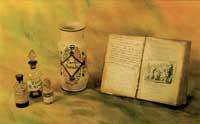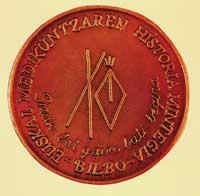Basque Museum of Science History
The main promoter and creator of this museum is Dr. José Luis Goti Iturriaga, currently responsible and director.

It is a University Foundation legally, run by a Board of Trustees and with diverse staff. The Basque Government approved the Basque Museum of Medical and Scientific History Foundation. He directs the Governing Council of the Museum Foundation, chaired by the Rector of the UPV/EHU. Its members are people from the university, scientific and cultural world of the Basque Country.
But to know where the creation of this museum comes from we have to go to 1969. Koldo Mitxelena, Joxe Miel Barandiaran, Escudero, Basabe and others met in the anthropology week that year. Dr. Goti, after completing his doctoral thesis in the 1960s, wanted to devote himself to Basque medicine. He received numerous grants from people from culture, science, medicine and university and advanced; in 1979 he began teaching medicine in the Basque Country (Saturday morning at university).

And finally, thanks to the objects, materials, books and documents provided by doctors and academics, the museum opened on May 25, 1982. The then professor Monreal was rector and Dr. Mendez dean of the Faculty of Medicine. There were, among others, Julio Caro Baroja and Joxe Miel Barandiaran.
The museum has hosted several days, round tables and events, as informed by Dr. Goti. “ The museum has different objectives and functions. On the one hand, scientific and cultural interest. On the other hand, the objective is teaching or didactic: students perform medical practices and what they learned here serves for the exam.” On 25 January this year, the museum's equipment was launched and more than 200 people attended this interesting show.
As for the number of regular visitors, it can be said that every year there are about two thousand people. However, more and more people come to it, as the museum is increasingly known.
21 attractive roomsBeginning with the three halls of the Faculty of Medicine, the first is the Granjel room. Seminar Room, Teaching Room and Library. Various conferences, events and round tables were held there. The first microscopes of Bilbao and the tools of ophthalmological and urological surgery of the Carlist era stand out. The second room offers a historical view of healthcare: On the one hand is the part of the belief of Folk Medicine and on the other the empirical part. Note the letter of Joxe Miel Barandiaran. The third and last room of the Faculty of Medicine, the Barriola room, is dedicated to surgical treatment. You can visit an operating room of the last century, with original doors, operating table, operating lamps and surgical material of the time. Next to it is the first artificial heart used in Bilbao. After a walk through the Leioa campus, we headed to the first floor of the Library Building. Here we have sixteen rooms to visit. First, in the Caro Baroja room we have the opportunity to enjoy the beautiful early century office of Dr. Aristegi. Opposite the Caro Baroja room is the Monreal room. The 50 exhibits allow us to know preventive medicine, such as boiling technique to kill germs. The next room is dedicated to the identification of diseases. XIX. and XX. Here is a collection of beautiful microscopes of centuries. In the Weights and Measures room more than 20 balances are shown. The Bilbao Metro, used as a pattern in the litigation that took place in Bilbao by measure, is particularly striking. The Clinical Laboratory is accessible below. Clinical analysis equipment (urometers, polarimeters, hemometers, etc. ). ), in addition to a wide library and anatomical drawings, among others. The ninth is the Aranzadi room, dedicated exclusively to the Natural Sciences. Remains of prehistoric animals, dinosaur bones of Laño (Alava) and remains of mineral. The following five rooms are dedicated to medical specialties: Endoscopy, Dentistry, Ophthalmology, Cardiology and Medical Botany (explaining the world of Phytotherapy). Room 16 is iconographic, an exhibition with slides of the health institutions of the Basque Country. Pharmaceutical issues appear in the Goiriena room of Gandarias. It contains a collection of kits of more than a thousand substances and tissues. Undoubtedly, an ideal place to know the history of the drug. The Elhuyar room was created to promote the teaching of technology in the Basque Country. The material collected thanks to Professor Alvarez Isasi can be divided into two parts: on the one hand, the mere history of technology and instruments prepared for special and practical techniques; and on the other, the audiovisual methods for teaching, the instruments for teaching. Highlights include the manual cinema camera from the beginning of the century, the projector for reading didactic documents on screen and the light projector of the optical laboratory. The last room is tocogynaecology. Old wooden tocoginecological tables are exhibited. In it we are offered the possibility of knowing the way in which women performed childbirth. Finally, it is worth mentioning that the reform of the Achucarro room is currently underway. In this room, which will be inaugurated soon, the laboratory material will be specially exposed. |
To know WORKING HOURS |





